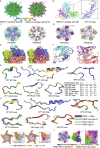Structural and molecular basis for foot-and-mouth disease virus neutralization by two potent protective antibodies
- PMID: 33599962
- PMCID: PMC9095805
- DOI: 10.1007/s13238-021-00828-9
Structural and molecular basis for foot-and-mouth disease virus neutralization by two potent protective antibodies
Figures


References
-
- Harmsen MM, van Solt CB, Fijten HP, van Keulen L, Rosalia RA, Weerdmeester K, Cornelissen AH, De Bruin MG, Eble PL, Dekker A. Passive immunization of guinea pigs with llama single-domain antibody fragments against foot-and-mouth disease. Vet Microbiol. 2007;120:193–206. doi: 10.1016/j.vetmic.2006.10.029. - DOI - PubMed
-
- Harmsen MM, Fijten HPD, Westra DF, Coco-Martin JM. Effect of thiomersal on dissociation of intact (146S) foot-and-mouth disease virions into 12S particles as assessed by novel ELISAs specific for either 146S or 12S particles. Vaccine. 2011;29:2682–2690. doi: 10.1016/j.vaccine.2011.01.069. - DOI - PubMed
Publication types
MeSH terms
Substances
LinkOut - more resources
Full Text Sources
Other Literature Sources
Molecular Biology Databases

